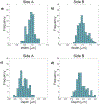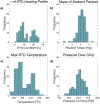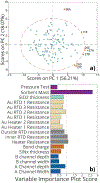Data-Driven Approach to Modeling Microfabricated Chemical Sensor Manufacturing
- PMID: 38156894
- PMCID: PMC11015434
- DOI: 10.1021/acs.analchem.3c04394
Data-Driven Approach to Modeling Microfabricated Chemical Sensor Manufacturing
Abstract
We have developed a statistical model-based approach to the quality analysis (QA) and quality control (QC) of a gas micro pre-concentrator chip (μPC) performance when manufactured at scale for chemical and biochemical analysis of volatile organic compounds (VOCs). To test the proposed model, a medium-sized university-led production batch of 30 wafers of chips were subjected to rigorous chemical performance testing. We quantitatively report the outcomes of each manufacturing process step leading to the final functional chemical sensor chip. We implemented a principal component analysis (PCA) model to score individual chip chemical performance, and we observed that the first two principal components represent 74.28% of chemical testing variance with 111 of 118 viable chips falling into the 95% confidence interval. Chemical performance scores and chip manufacturing data were analyzed using a multivariate regression model to determine the most influential manufacturing parameters and steps. In our analysis, we find the amount of sorbent mass present in the chip (variable importance score = 2.6) and heater and the RTD resistance values (variable importance score = 1.1) to be the manufacturing parameters with the greatest impact on chemical performance. Other non-obvious latent manufacturing parameters also had quantified influence. Statistical distributions for each manufacturing step will allow future large-scale production runs to be statistically sampled during production to perform QA/QC in a real-time environment. We report this study as the first data-driven, model-based production of a microfabricated chemical sensor.
Figures









References
-
- Mandoj F; Nardis S; Di Natale C; Paolesse R, Porphyrinoid Thin Films for Chemical Sensing. In Encyclopedia of Interfacial Chemistry, Wandelt K, Ed. Elsevier: Oxford, 2018; pp 422–443.
-
- Kaniewska M; Trojanowicz M, Chapter 8 - Chiral Sensors Based on Molecularly Imprinted Polymers. In Molecularly Imprinted Sensors, Li S; Ge Y; Piletsky SA; Lunec J, Eds. Elsevier: Amsterdam, 2012; pp 175–194.
-
- Pan TM; Mondal S, 13.07 - Structural Properties and Sensing Characteristics of Sensing Materials. In Comprehensive Materials Processing, Hashmi S; Batalha GF; Van Tyne CJ; Yilbas B, Eds. Elsevier: Oxford, 2014; pp 179–203.
-
- Rudnitskaya A., Sensors | Biomimetic Sensor Arrays. In Encyclopedia of Analytical Science (Third Edition), Worsfold P; Poole C; Townshend A; Miró M, Eds. Academic Press: Oxford, 2019; pp 154–160.
-
- Güntner AT; Abegg S; Königstein K; Gerber PA; Schmidt-Trucksäss A; Pratsinis SE, Breath Sensors for Health Monitoring. ACS Sens. 2019, 4 (2), 268–280. - PubMed

